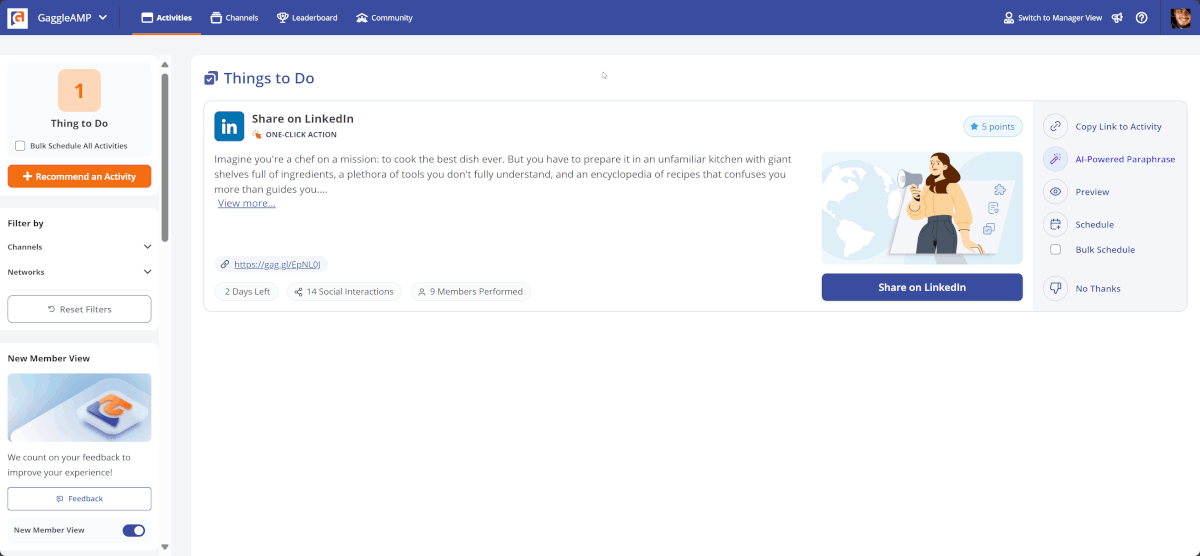Social Media Marketing: A Strategic Guide for B2B Teams
Social media isn’t a campaign — it’s your brand’s behavior.
Think of social media marketing as architecture — every post, comment, and share is a brick in the structure your brand builds over time. Without a blueprint, you get noise. With one, you create something enduring: a presence that’s visible, trusted, and built to support real business growth.
In this digital town square, brands aren’t just speaking at their audiences — they’re speaking with them, listening in real time, and earning visibility through relevance and resonance.
Understanding Modern Social Media Marketing
In the earliest days of social media, brands treated digital channels like digital billboards — spaces to broadcast updates, post promotions, and “stay present.” But that model hasn’t just aged. It’s cracked.
Today, social media marketing is no longer just a tactic. It’s a dynamic, always-on strategy that sits at the heart of brand visibility, community development, and business growth. At its core, social media marketing is the process of using platforms like LinkedIn, Facebook, Instagram, YouTube, and others to strategically connect with target audiences, create and distribute content, and drive measurable outcomes — from brand lift to lead generation.

Understanding these layers matters because most B2B teams underutilize the most credible and scalable mode: employee advocacy. According to the Content Marketing Institute, 89% of B2B marketers use social media to distribute content organically, but far fewer activate their internal networks — leaving reach, trust, and leads on the table.
Why Strategy-First Social Wins the Buyer Journey
Here’s why this evolution isn’t just tactical noise. For B2B leaders, failing to evolve your social strategy means:
-
Missing relevance in the buyer journey’s earliest stages
-
Losing control of brand narrative in public forums
-
Over-indexing on paid spend without compounding engagement
In contrast, a sophisticated social media approach — one that integrates brand voice, employee participation, and platform-native behavior — creates flywheel effects: more trust, more traffic, more pipeline.
Social media and marketing are no longer separate initiatives — they’re interdependent systems that inform content strategy, buyer journeys, and how brands earn trust in public.
Why Social Media Marketing Matters in 2025
In 2025, marketing on social media isn’t optional — it’s foundational. Yet as algorithms shift and audience expectations evolve, most brands find themselves working harder for less visibility.
Social platforms have matured into algorithm-driven ecosystems that prioritize content relevance, engagement signals, and user behavior over simple frequency or follower count. Meanwhile, audiences have grown more discerning. They expect speed, substance, and sincerity — not just updates. This evolution creates a tension: content fatigue is rising, but the demand for meaningful, brand-aligned interactions hasn’t waned.
Why Organic Reach Alone No Longer Delivers
Here’s the reality many marketers are quietly wrestling with — organic reach is nosediving. LinkedIn, long favored by B2B marketers, now shows organic posts to a smaller portion of a company’s followers unless they spark early engagement. Meta’s platforms (Facebook and Instagram) have tightened algorithmic visibility, favoring paid content and user-driven signals. TikTok’s “For You” feed favors creators over corporate pages.

That means even high-quality content can vanish into the scroll unless it’s designed to spark action — likes, comments, shares — immediately.
What Happens When Content Lacks a Strategic Spine
This is where the danger lies. Many B2B organizations respond to these shifts by increasing content volume, not content intentionality. But more posts don’t equal more presence — they often lead to brand dilution, platform fatigue, and wasted resources.
Without a strategic lens, even well-designed content risks becoming just another post in an oversaturated feed. The result? Audiences disengage. Marketing feels futile. And CMOs struggle to justify budget allocation to what feels like a black box.
How a Smarter System Translates Into Measurable Growth
Winning in 2025 doesn’t require more content. It requires a smarter, systems-level approach — where social media aligns with your brand identity, speaks to each audience segment with precision, and distributes content through a blend of owned, earned, paid, and employee-driven channels.

This doesn’t mean every post must be polished or every campaign hyper-optimized. But it does mean every social action must ladder up to business outcomes: visibility, trust, lead flow, or conversion readiness.
A strategic social media marketing approach includes:
-
Matching channel to customer journey stage
-
Aligning tone and format to platform norms
-
Leveraging employee voices to build trust
-
Measuring engagement as a leading indicator, not a vanity metric
What B2B Teams Gain by Operationalizing Social Strategy
When strategy drives execution, social media shifts from cost center to growth engine. Tangible business benefits include:
-
Stronger brand equity: consistent voice and visual identity across channels build familiarity
-
Demand generation lift: strategic posting cadence and employee engagement boost content visibility
-
Improved SEO: content shares create backlinks, traffic spikes, and domain authority
-
Lower customer acquisition cost (CAC): organic and earned reach offset reliance on paid channels
This is where the semantic intent behind search terms like “bottom line”, “enhance brand”, and “engaging content in real time” aligns with executive pressure — to do more with less, and do it faster.
Social media marketing in 2025 isn’t about being everywhere. It’s about showing up where it matters, with the right message, in the right voice, and through the right people — your team.
Core Components of a Successful Social Media Strategy
Most social media content plans look tidy in a slide deck — content calendar, brand voice guide, maybe a few hashtags for good measure. But when campaigns underperform or engagement flatlines, marketers realize what’s missing isn’t creativity. It’s strategy.
True strategy isn't about scheduling posts. It’s about defining purpose, aligning channels to business goals, and grounding your marketing communication strategy in a system where every piece of content plays a measurable role in the buyer journey. That’s why the most successful social media programs rely on a framework of interlocking components — each one designed to scale clarity, consistency, and performance.
How to Build a Strategy That Aligns Channels, Messaging, and Metrics
-
Clear Goals: Start with outcomes, not outputs. Are you driving awareness? Nurturing leads? Supporting recruitment? Your KPIs should ladder directly to these goals.
-
Audience Segmentation: Who are you speaking to — and where are they in the journey? Segment by role, stage, or industry, and tailor messaging accordingly.
-
Messaging Framework: Define key narratives, proof points, and tone guidelines. These ensure every post contributes to your core brand message.
-
Content Pillars: Map content types (e.g., thought leadership, customer stories, product tips) to platform strengths and audience needs.
-
Platform Strategy: Don’t treat every platform equally. Choose your mix based on business goals (LinkedIn for B2B engagement, YouTube for tutorials, X for thought leadership).
-
Publishing Cadence: Set a realistic rhythm. Consistency beats volume. Align cadence with your team’s workflow and audience appetite.
-
Analytics & Feedback Loop: Use platform data, engagement metrics, and qualitative input to refine what works and scrap what doesn’t.
This strategic map is what transforms a social media marketing plan into a social media marketing strategy — a living system rather than a set-it-and-forget-it spreadsheet.
Paid vs. Organic vs. Earned: Integrating the Full Media Mix
B2B teams often default to either posting organically or running paid ads, rarely recognizing that a full social strategy blends four powerful modes: organic, paid, earned, and employee-driven. Each has distinct levers, and understanding how these types of social media marketing work together is key to creating compounding reach.
What Each Social Channel Type Brings to the Table
Let’s anchor the core definitions:
-
Organic Social
Content published directly to your brand’s social channels, unpaid. Think: blog shares, industry commentary, hiring updates.-
Strength: Builds long-term trust and consistency
-
Limitation: Limited reach without engagement or frequency
-

-
Paid Social
Sponsored content amplified through advertising spend. Think: LinkedIn Sponsored Content, Meta ads, retargeting.-
Strength: Fast reach, precise targeting, scalable impressions
-
Limitation: High cost, low credibility
-

-
Earned Social
Mentions, shares, tags, and user-generated content. Think: customers sharing results, employees posting wins, influencers tagging your brand. This includes employee-driven social — a high-trust, low-cost form of earned reach that scales credibility and internal culture through personal networks.-
Strength: Highest trust value and virality potential
-
Limitation: Hard to control or predict
-

Each mode has distinct cost, control, and scalability dynamics. The key isn’t to choose one — it’s to synchronize them.
Where Paid, Earned, and Organic Each Add Funnel Value
| Media Type | Funnel Role | Strategic Leverage |
|---|---|---|
| Organic | Awareness + Nurture | Consistency, brand tone, audience education |
| Paid | Consideration + Demand | Targeted amplification, lead generation |
| Earned | Trust + Influence | Social proof, authority, word-of-mouth scale |
A high-performing B2B social program uses organic content to build relevance, paid media to drive conversion, and earned media to validate credibility.
Why Employee Advocacy Bridges Trust and Scale
Here’s where the lines blur — and the magic happens. Employee-driven social sits at the intersection of organic and earned. It’s:
-
Controlled by the brand (via frameworks or advocacy tools)
-
Delivered through trusted personal channels
-
Capable of organic amplification and earned response
This hybrid model is where credibility meets consistency. A platform like GaggleAMP enables brands to scale this bridge — assigning activities, tailoring messages, and tracking performance — without manual management or brand risk.
How to Build a Unified Media Mix That Performs
-
Start With Organic Foundations
Establish your content cadence and voice across core channels. -
Amplify With Paid Smartly
Promote high-performing organic content. Don’t guess — boost what already works. -
Activate Earned Intentionally
Encourage user stories, share customer testimonials, celebrate employee posts. -
Operationalize Advocacy
Use a platform like GaggleAMP to drive participation without the chaos of manual outreach. -
Track Cross-Channel Attribution
Use UTMs, dashboards, and performance models to understand what’s driving outcomes.
How Integration Unlocks Social Scale
When you rely solely on paid, you buy awareness but miss authenticity. When you rely only on organic, you limit reach. When you hope for earned without structure, you wait too long.
The most efficient path in 2025 is integration — where every piece of content serves a dual purpose, and every platform touchpoint contributes to the larger system of effective social media marketing.
Social Media Platforms Explained: Choosing the Right Channels
Every marketer feels the gravitational pull of “be everywhere.” But in 2025, ubiquity without purpose is a trap. The more strategic question isn’t how many platforms are you on? It’s which platforms align with your business objectives, audience behavior, and content capacity?
Understanding the ecosystem of modern social media platforms means making intentional choices — not chasing the latest trend, but aligning platform dynamics with audience expectations and business outcomes.
What Each Platform Actually Delivers in a B2B Context
Each platform has a native personality, a default pace, and an unwritten social contract between users and content creators. Here’s how to decode them for B2B application:
-
LinkedIn
The definitive B2B hub. Ideal for brand authority, employee advocacy, executive thought leadership, and lead generation.
-
Best for: Whitepapers, industry commentary, hiring updates, webinars
-
Strategic hook: Great for building reach via employee networks
-

-
YouTube
Think of YouTube as a hybrid: part SEO engine, part educational library. Particularly effective for product demos, long-form interviews, and how-tos.-
Best for: Tutorials, explainer series, case study videos
-
Strategic bonus: Evergreen traffic + high time-on-content
-

-
Instagram
Often dismissed in B2B, but increasingly valuable for brand personality, behind-the-scenes culture, and employer branding.-
Best for: Reels, team takeovers, event stories
-
Strategic use: Visual storytelling to humanize your brand
-

-
Facebook
While declining in organic reach, it still plays a role in groups, community building, and paid targeting.-
Best for: Alumni networks, customer communities, niche B2B interest groups
-
ICP nuance: Useful for post-sale engagement and support content
-

-
X (formerly Twitter)
Real-time pulse for industry news, hot takes, and executive visibility.-
Best for: Live event commentary, curated threads, brand personality
-
Strategic edge: High-velocity platform for thought leadership snippets
-

-
TikTok
Not just Gen Z dance videos. Brands are using it for digestible thought leadership, FAQ breakdowns, and trendjacking.-
Best for: Short-form explainer videos, culture-led storytelling
-
Caution: Requires authenticity and creativity — not easy to repurpose corporate content
-

How to Match Platform to Business Goals with Precision
To help ICP-aligned teams choose wisely, consider this matrix:
| Business Goal | Best-Fit Platform(s) |
|---|---|
| Increase brand awareness | LinkedIn, YouTube, TikTok |
| Enhance employer brand | Instagram, LinkedIn |
| Generate leads | LinkedIn, Facebook Ads |
| Support post-sale engagement | Facebook Groups, YouTube |
| Boost executive visibility | LinkedIn, X |
| Create product education | YouTube, LinkedIn |
This isn’t prescriptive. It’s diagnostic. Platform mix should reflect where your audience lives, what kind of content they expect, and how your team can sustain participation. The key is to ask: What is the platform optimized to deliver — and how does that match my objective?
How Buyer Stages Shape Platform Strategy
Social strategy must evolve across the buyer journey. Here's a simplified mapping:
| Funnel Stage | Platform Focus | Content Type | Primary KPI |
|---|---|---|---|
| Awareness | LinkedIn, YouTube | Thought leadership, blogs | Impressions, reach |
| Consideration | LinkedIn, Email | Case studies, demos | Click-through rate |
| Decision | Sales-assisted, 1:1 DMs | Proof assets, ROI calculators | Meetings booked, MQLs |
This flywheel-like model echoes HubSpot’s Flywheel or SOSTAC frameworks — where each stage is not siloed but designed to propel the next.
Why Fewer Platforms Drive Deeper Engagement
Spreading thin is easy. But brand consistency, engagement rhythm, and employee advocacy thrive when focus narrows. Rather than posting weekly on five platforms, it’s often more strategic to post daily on one.
This is especially true when activating employee-driven amplification. When posts are native to the platform and relevant to the employee’s audience, participation skyrockets.
The question isn’t which social media platform is best for marketing? It’s which platform is best for the message, audience, and moment you’re in right now?
Social Media Content Creation: Formats, Frequency, and Frameworks
If strategy defines the “what” and “why” of social media marketing, content is the “how.” But creating effective content in 2025 isn’t just about clever copy or slick design. It’s about format-platform fit, message-audience relevance, and consistent rhythm that aligns with business outcomes.
To create content that performs — not just publishes — marketers must consider three layers: format, frequency, and framework. This section breaks them down to help your team build a content engine that educates, engages, and converts.
Which Content Formats Drive Engagement
Not all formats are created equal. And not all formats travel equally across platforms. Here’s a breakdown of high-performing social formats and when to use them:
-
Short-form Video (Reels, TikToks, LinkedIn clips)
-
Use for: Product walkthroughs, quick tips, event recaps
-
Platform fit: Instagram, TikTok, LinkedIn
-
Best when: Speed and personality matter more than polish
-
-
Carousels (Multi-slide LinkedIn/Instagram posts)
-
Use for: Listicles, tutorials, storytelling
-
Platform fit: LinkedIn, Instagram
-
Best when: You want engagement depth — carousels increase dwell time
-
-
Polls and Interactive Posts
-
Use for: Market research, engagement prompts
-
Platform fit: LinkedIn, Facebook
-
Best when: You want participation, not just attention
-
-
Stories and Live Streams
-
Use for: Announcements, behind-the-scenes, thought leadership Q&A
-
Platform fit: Instagram, YouTube, Facebook
-
Best when: Urgency or personality drives interest
-
-
Long-form Posts and Articles
-
Use for: Strategic opinions, executive insights
-
Platform fit: LinkedIn, Medium, company blogs
-
Best when: Building thought leadership or category ownership
-
A sophisticated content plan doesn’t just repurpose content — it repackages insights in native formats that suit both platform algorithms and audience expectations.
How Message Themes Shape Brand Perception
Successful brands rotate across formats — thought leadership, education, cultural moments — but the real differentiator lies in how those themes ladder into platform behavior and buyer intent. Developing structured, platform-aware content strategy themes prevents repetition and makes each post distinct, not derivative.

HubSpot announces their product updates through a video on LinkedIn


When teams rotate through these consistently, they avoid both fatigue and redundancy — and ensure each post plays a distinct business role.
When to Post and Why Rhythm Beats Volume
Posting too often without strategy burns out both audience and internal resources. Posting too little makes your brand invisible. The solution is rhythmic publishing — calibrated to platform norms and your bandwidth.
Recommended baselines:
-
LinkedIn: 3–5x/week (daily for high engagement)
-
Instagram: 3x/week + 3–5 stories/week
-
YouTube: 1 long-form or 2 shorts/week
-
Twitter/X: 1–3x/day
-
TikTok: 3–4x/week for early traction, 1x/day for scale
Content isn’t just output — it’s your brand’s behavior in public. Structure, rhythm, and measurement turn it from noise into narrative.
Building a Strategic Social Media Marketing Blueprint
Building a social media marketing plan from scratch is less about generating ideas and more about establishing infrastructure. The difference? One is a brainstorm. The other is a blueprint for how your brand shows up, builds trust, and drives outcomes — across every channel, every week, for the long haul.
But blueprints don’t need to start from scratch. A structured social media marketing template can act as your scaffolding — helping you organize goals, map out content pillars, and visualize campaign timing before the first post goes live. With the right framework, execution becomes less reactive and more repeatable.
That’s why what follows isn’t just a checklist — it’s the foundational sequence for building a strategy that scales. Each step is designed to help you construct a system that aligns goals, content, and execution into a unified social media presence.
Step 1: Understand Your Audience, Competitors, and Topic Landscape
Before writing a single post, immerse yourself in:
-
Audience insights: What do your buyers read, click, and comment on? Tools like SparkToro and LinkedIn Polls can surface psychographic nuance.
-
Competitor analysis: Audit platform presence, content formats, engagement rates, and tone across your key competitors.
-
Keyword & topic research: Use SEMrush, Google’s People Also Ask, and LinkedIn search to identify high-interest topics tied to your ICP’s business goals.
This diagnostic phase reveals not just what to post, but why, where, and when.
Step 2: Set Clear, Tiered Goals That Reflect Real Business Outcomes
Avoid vague objectives like “increase engagement.” Instead, ladder your social goals to broader business metrics.
| Tier | Example Goal | KPI Example |
|---|---|---|
| Strategic | Increase brand awareness | Impressions, brand search lift |
| Campaign | Drive webinar signups | Click-through rate, registrations |
| Tactical | Boost LinkedIn post engagement | Comments, shares, reactions |
Make each goal time-bound, platform-specific, and performance-oriented. That’s how you move from vanity metrics to business impact.
Step 3: Select Your Platforms With Intention
Revisit your research. Align platform mix with:
-
Your ICP’s platform habits
-
Your content capacity (video, visual, copy)
-
Your employee advocacy potential
Don’t aim to be on every channel. Aim to be consistent and credible on the ones that matter most.
Step 4: Build a Messaging Framework that Scales
This is your playbook for how your brand sounds — and how it adapts across roles and regions.
-
Brand narrative: Core story, tone, and themes
-
Audience segments: What each persona cares about, avoids, and needs proof for
-
Message variants: Adjusted copy per function (e.g., execs vs. HR vs. sales)
GaggleAMP’s advocacy structure supports this by enabling message tailoring per employee group, ensuring each share reflects platform and persona nuance.
Step 5: Build a Content Roadmap and Calendar
Start with 3–4 content buckets:
-
Educational (e.g., “how to” guides)
-
Cultural (e.g., team spotlights)
-
Promotional (e.g., product announcements)
-
Thought leadership (e.g., executive POVs)
Then map these into a repeatable calendar cadence. Tools like Notion, Airtable, or GaggleAMP’s activity manager make this scalable.
Aim for:
-
Daily LinkedIn posts (minimum 3x/week)
-
Weekly long-form pieces for YouTube, blogs, or newsletters
-
Real-time response capacity for platform events and comments
Step 6: Define Your Metrics and Feedback Loops
Social media is only as valuable as its attribution clarity. From Day 1, decide how you’ll track:
-
Post-level engagement (likes, shares, comments)
-
Click-throughs and traffic (UTMs, GA4)
-
Conversion impact (lead gen forms, demo bookings)
-
Advocacy performance (reach and EEMV via GaggleAMP dashboards)
Add qualitative insights from employee feedback and buyer conversations to round out your analytics.
Why Documented Strategy Beats Guesswork Every Time
A documented plan isn’t just about predictability — it’s about scalability, accountability, and insight. It aligns your team, empowers your advocates, and converts social media from a side project into a core business function.
By anchoring your efforts in frameworks, cadence, and measurement — not just creativity — you set the stage for repeatable, compounding success.
Metrics That Matter: Measuring ROI on Social Media Marketing
The biggest myth in social media marketing? That ROI is fuzzy, immeasurable, or "just brand stuff." In reality, the challenge isn’t measurement — it’s knowing what to measure, when to measure it, and how to make sense of the data.
In 2025, the social landscape rewards marketers who understand both quantitative KPIs and the qualitative signals that precede conversion. To justify investment, optimize performance, and earn cross-functional buy-in, brands must treat social media data like business intelligence — not vanity scorecards.
Understanding how that data translates into revenue starts with choosing the right lens. Because of longer sales cycles and multi-touch journeys, measuring social media ROI for B2B requires more than tracking likes or clicks — it means linking engagement to pipeline, customer value, and influence across channels.
Which KPIs Actually Reflect Strategic Progress
To demystify measurement, start by mapping metrics to business goals:
| Business Objective | Primary Metrics |
|---|---|
| Increase brand awareness | Impressions, reach, brand search volume |
| Drive engagement | Likes, shares, comments, dwell time |
| Generate demand | Click-through rate (CTR), demo bookings |
| Build trust | Share of voice, sentiment, mentions |
| Prove ROI | Conversion rate, CAC, revenue attribution |
Every platform provides dozens of data points — but only a handful tie directly to the bottom line. Define success before campaign launch, so you’re not retrofitting metrics to justify outcomes.
Use attribution tools (like GA4, HubSpot, or Dreamdata) to match metrics to touchpoints. Even employee advocacy can be tracked using UTMs and activity dashboards within GaggleAMP, surfacing data often invisible in traditional social reports.

Because social media often influences buyers before they’re measurable, effective ROI tracking demands a multi-touch model. Structuring UTMs, traffic tagging, and conversion paths with clarity is essential to scaling performance — particularly if your goal is to increase your social reach beyond vanity metrics.
Why Unified Dashboards Outperform Siloed Metrics
Platform analytics (e.g., LinkedIn Analytics, Meta Insights) are valuable — but siloed. For a full picture, unify social metrics into a central dashboard that integrates:
-
Website traffic and behavior (GA4)
-
CRM data (HubSpot, Salesforce)
-
Advocacy engagement (GaggleAMP)
-
Campaign performance (UTMs, Bitly, ad platforms)

This view allows marketing to answer not just “what got clicks?” but “what drove qualified leads, conversations, and revenue?”
What Industry Benchmarks Reveal About Realistic ROI
To give stakeholders perspective, contextualize performance against benchmarks:
-
LinkedIn average engagement rate: 2–3%
-
Click-through rate (B2B average): 0.67% (paid)
-
Organic reach (LinkedIn): <10% of followers
-
Employee advocacy CTR: Often 2x–3x brand page CTR
-
Earned media value (via GaggleAMP): Avg. $61,718 annually per Gaggle
These numbers aren’t targets — they’re context. What matters most is consistent improvement and business alignment.
How ROI Visibility Earns Budget and Buy-In
When social media is measured only in likes, it gets managed like a side project. When it’s measured in influence, conversions, and pipeline contribution, it earns budget, headcount, and executive sponsorship.
Social isn’t a soft metric channel. It’s a revenue multiplier — if you track it like one.
Common Mistakes in Social Media Marketing and How to Avoid Them
Social media isn’t underperforming. It’s often just misunderstood. So, why do social campaigns fail?
B2B marketers frequently approach social like a campaign channel — episodic, or tethered to product launches. But social media’s power lies in compounding consistency, not occasional bursts. Missteps usually come from well-intentioned teams who confuse activity with strategy, or creativity with clarity.
Here are the most common mistakes brands make — and how to fix them before they erode credibility, waste resources, or exhaust your team.
No Strategy, Just Posting
The Problem: Publishing content without a roadmap — reacting to news cycles, product timelines, or calendar holes.
Why It Hurts: Your message becomes fragmented. Your audience becomes confused. And your internal team burns out chasing engagement.
The Fix: Anchor every post to a core strategy: audience segment, funnel stage, and business outcome. Use frameworks like SOSTAC to guide cadence, content, and channel focus.
Inconsistent Voice and Frequency
The Problem: Tone varies by writer, frequency shifts by quarter, and some platforms go dark for weeks.
Why It Hurts: Inconsistency breeds distrust. Audiences don’t know what to expect — and forget you quickly.
The Fix: Define brand voice guidelines. Choose a realistic publishing cadence per platform. Build SOPs so new team members can execute without reinventing the wheel.
Chasing Trends Without Context
The Problem: Jumping on TikTok dances, viral memes, or breaking news — even when they don’t align with brand values or audience needs.
Why It Hurts: It dilutes your brand identity and confuses your audience. Worse, it often falls flat.
The Fix: Ask: “Does this trend advance our business goal or deepen audience connection?” If not, skip it. Focus instead on timeless insights delivered in timely formats.
Neglecting Analytics
The Problem: Measuring likes, glancing at impressions, and never revisiting past campaigns.
Why It Hurts: You can’t optimize what you don’t analyze. And you can’t prove impact without benchmarks.
The Fix: Track metrics that map to funnel stages and audience intent. Use dashboards (e.g., GaggleAMP, GA4, LinkedIn Analytics) to learn what’s working — and replicate it intentionally.
Ignoring Employee Engagement
The Problem: Social is managed solely by Marketing. Employees aren’t invited or equipped to participate.
Why It Hurts: Your content stays confined to your corporate page — limiting reach, credibility, and trust.
The Fix: Use employee advocacy tools like GaggleAMP to assign content, track engagement, and gamify participation. Build workflows that integrate with Slack or Teams to reduce friction.
Misjudging Platform Intent
The Problem: Posting the same message across all channels without adjusting format or tone.
Why It Hurts: What works on LinkedIn often flops on Instagram. Format ignorance signals tone-deafness.
The Fix: Treat each platform as its own ecosystem. Repurpose insights, not posts. Adapt visuals, copy length, and CTAs to fit platform behavior.
Prioritizing Quantity Over Clarity
The Problem: “We need to post daily” becomes the mantra — regardless of message quality or strategic alignment.
Why It Hurts: You publish more but say less. Your team grows fatigued, and your audience tunes out.
The Fix: Publish with purpose. It’s better to show up consistently with insight than loudly with filler. Quality creates reputation gravity.
When Missteps Cost More Than Just Clicks
The cumulative cost of these mistakes is more than a few lost clicks. It’s eroded trust, wasted budget, and internal misalignment.
Avoiding them isn’t about perfection — it’s about orchestration. When content, cadence, and culture align, social media becomes a growth engine — not just a megaphone.
Building Authentic Connections: The Future of Social Media Engagement
There’s a quiet revolution happening in social media — and it’s not about new platforms, formats, or algorithms. It’s about how brands behave. Engagement today is no longer measured by surface-level metrics. It’s earned through authenticity, consistency, and conversational presence.
For brands in 2025, social media engagement isn’t a goal. It’s a byproduct — of relevance, trust, and human resonance. And that means the future isn’t robotic automation or polished corporate posts. It’s people talking to people, at scale, with intention.
Why Engagement Is Now Measured in Conversations
Marketers once asked, “What content gets the most likes?” Now they ask, “What content starts meaningful conversations?”.
This shift is especially profound in B2B, where trust drives buying behavior. According to Forbes, employee-shared content receives 8 times more engagement than content shared by brand channels
What Actually Motivates Followers to Interact
What compels someone to comment, repost, or DM in response to a brand’s post? It’s not just relevance — it’s emotional alignment. That’s why authentic engagement now outperforms polished campaigns. It signals trust, invites community, and reflects a brand's humanity more than its design.
The modern audience craves:
-
Transparency: Brands that admit missteps and share process.
-
Vulnerability: Leaders who speak from experience, not authority.
-
Consistency: A reliable presence that feels familiar, not forced.
-
Relevance: Posts that reflect their goals, not your roadmap.
Engagement becomes a relational signal — a handshake, not a metric.
Real-Time Interaction as Trust Currency
In a world of bots and automation, real-time response is a differentiator.
-
Replying to comments shows respect.
-
Answering DMs builds loyalty.
-
Joining platform-native conversations (like Twitter/X threads or LinkedIn comment sections) builds thought leadership by proximity.
These micro-interactions, scaled across teams, compound into perceived accessibility — a major trust driver in vendor selection.
When Employee Voices Reshape Brand Identity
When employees speak in their own voices, credibility scales faster than any brand campaign. Effective advocacy is rooted in authenticity — not scripts — and that's what drives authentic engagement that converts followers into champions.
Consider how brands like Notion or ClickUp win the feed not with ads, but with employees sharing behind-the-scenes moments, user tips, or milestone reflections — in voices that sound human, not PR-approved.

Platforms like GaggleAMP enable this shift by giving employees:
-
Curated content they can personalize
-
One-click sharing across preferred platforms
-
Recognition via gamified leaderboards
This isn’t just internal enablement. It’s external amplification with authenticity baked in.
Social media presence isn’t about posts. It’s about participation. The brands that will own the next decade aren’t the loudest — they’re the most human.
Protecting Your Brand: Creating an Effective Social Media Policy
When a brand scales its social presence — especially through employee advocacy — the greatest risk isn’t a PR disaster. It’s ambiguity.
Without clear guardrails, teams hesitate to share. Or worse, they post off-message. That’s why the most forward-thinking companies treat social media policies not as rulebooks, but as enablement frameworks — balancing compliance with creativity, governance with empowerment.
In 2025, a smart social media policy doesn’t limit brand participation. It fuels it, safely.

Why Social Media Policies Matter More Than Ever
As brands increase their reliance on employee voices, real-time response, and cross-functional content, risk exposure multiplies. These aren’t hypothetical risks:
-
An exec’s off-the-cuff comment spirals into negative coverage
-
A well-meaning intern shares embargoed information
-
A disgruntled employee posts while still associated with your brand
In regulated industries (finance, healthcare, public sectors), the stakes are even higher — legal exposure, compliance breaches, and brand damage loom without clear protocols.
But even outside regulated spaces, reputation risk is operational risk. And that’s where policies provide a scalable foundation.
When Guardrails Support Trust at Scale
As employee engagement scales, the absence of clear guidelines becomes a liability. Building a smart, brand-positive social media policy isn’t just about compliance — it’s about removing hesitation and unlocking team participation.
How GaggleAMP Elevates Your Social Media Marketing Strategy
Most companies treat employee advocacy like a side project — a Slack ping here, an all-hands reminder there. But that approach doesn’t scale. It burns out marketers, frustrates employees, and delivers inconsistent results. The real unlock? Systematizing advocacy like any other strategic channel.
That’s where GaggleAMP doesn’t just fit in — it transforms the entire model.

Key Features That Drive Strategic Impact
-
Slack/Teams integration: Meet employees where they already work.
-
AI-generated copy options: Help users sound natural without writing from scratch.
-
Segmented group targeting: Assign tasks by role, department, or seniority.
-
Performance dashboards: Prove impact with metrics leadership cares about.
-
Gamification: Drive friendly competition with leaderboards and rewards.
These aren’t bells and whistles — they’re participation levers, designed to address the real friction that slows most advocacy efforts.
GaggleAMP enables what top-performing brands already prove: when employees share brand-aligned stories, reach multiplies. This shift from paid-first to people-first is clear in standout social media marketing examples across industries.
Frequently Asked Questions (FAQ)
Even seasoned marketers still ask foundational questions about social media marketing — not because they lack skill, but because the field evolves faster than most teams can operationalize. Below are clear, context-rich answers to the most pressing and popular queries — optimized for clarity and decision-making.
What Is Social Media Marketing?
Social media marketing is a structured approach to using platforms like LinkedIn, YouTube, Facebook, and others to increase brand visibility, engage target audiences, and drive measurable business outcomes. It integrates content, distribution, and analytics across paid, earned, and organic media.
How Does Social Media Marketing Benefit Businesses?
It boosts visibility, builds trust, and accelerates conversion. When aligned with business goals, social marketing supports lead generation, employee advocacy, recruitment, and customer loyalty — all while lowering cost per acquisition and increasing long-term engagement.
How Much Does Social Media Marketing Cost?
Costs vary based on your mix of organic, paid, and advocacy-based efforts. Paid campaigns typically start at a few dollars per thousand impressions, while organic and employee-driven programs rely more on internal resources and tools that streamline participation and tracking.
Which Social Media Platform Should My Business Use?
Choose platforms based on where your audience spends time and what type of content they expect. LinkedIn is ideal for B2B, YouTube for tutorials, Instagram for brand culture, and X for timely insights. Prioritize depth on 1–2 channels over shallow presence on many.
What Is the Difference Between Paid and Organic Social Media Marketing?
Paid social relies on advertising spend for reach and targeting; organic relies on owned content and audience engagement over time. Both can drive results, but paid offers speed while organic builds credibility and long-term value.
How Can I Measure the ROI of My Social Media Efforts?
Define KPIs aligned to funnel stages — impressions, engagement rate, click-throughs, and conversions — then track them via dashboards, UTMs, and CRM integrations. Multi-touch attribution models help quantify social's contribution to pipeline and revenue.
What Role Do Employees Play in Social Media Marketing?
Employees act as trusted brand amplifiers. When they share relevant, brand-aligned content, they expand reach, boost credibility, and drive engagement that outperforms traditional brand posts — especially in B2B.
How Do I Get Started With a Social Media Marketing Strategy?
Start by defining your audience, goals, and channel mix. Then create a content framework, publishing schedule, and analytics plan. Tools and workflows for employee engagement and performance tracking should follow — not precede — this foundational work.
Where to Start If You’re Ready to Scale Your Strategy
Social media marketing has outgrown its legacy role as a channel for brand announcements. It’s now a core business system — one that reflects your values, scales your visibility, and activates the most credible voices in your organization: your people.
But here’s the paradox: while tools have become more sophisticated, audiences have become more skeptical. Automation alone won’t cut it. What breaks through today is what feels real — human voices, shared perspectives, honest interactions.
If your current social media strategy ends with a brand page post and a hope that it gets seen, you’re leaving visibility, influence, and revenue on the table.
Schedule a demo to see how GaggleAMP turns your employees into brand advocates.



















